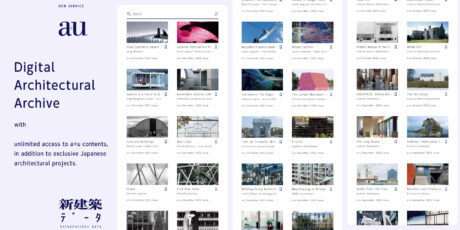News Announcement from a+u
a+u is pleased to announce the appointment of Seng Kuan as chief editorial advisor to the magazine, commencing in April 2021. In this role he will oversee the content and overall editorial agenda of the magazine. He succeeds Nobuyuki Yoshida, who served as editor in chief of a+u since 1996 and will remain as its publisher. Ayako Sato is promoted to senior editor. Founded in 1971 and published monthly in both English and Japanese, a+u celebrates its 50th anniversary in 2021. Sister publications of a+u include Shinkenchiku and Jutakutokushu, two Japanese-language monthly titles serving Japan’s community of architects.
a+u also announces the appointment of a new editorial board, consisting of Barry Bergdoll, Giovanna Borasi, and Andres Lepik – three of the most active and influential figures in architectural criticism and scholarship today. They will be working closely with Seng Kuan and the rest of a+u’s editorial staff in guiding the magazine as we continue to strive to provide the highest quality content in a rapidly evolving ecology of architectural production and discourse.

Chief Editorial Advisor
Seng Kuan is project associate professor at the University of Tokyo and lecturer at the Harvard Graduate School of Design. He has written extensively on Japan’s postwar architectural culture, including the “land, water, and sky” trilogy on the Metabolists; the role of structural engineering in modern Japanese architecture; and books on Kenzō Tange (2012) and Kazuo Shinohara (2021). His research projects have been recognized with major grants from the Graham Foundation and the Japan Foundation. He received his BA from Harvard University and afterward studied in both the architecture and urban planning programs at Harvard, ultimately graduating with a PhD in architectural history. Seng Kuan has previously served in various editorial positions at a+u. Most recently he edited monographic issues on architecten de vylder vinck taillieu (17:06) and Kenzō Tange’s Yoyogi National Gymnasiums (19:10).
Editorial Board
Barry Bergdoll is Meyer Schapiro Professor of Art History at Columbia University and the former chief curator in the Department of Architecture and Design at the Museum of Modern Art, New York (2007–14). A specialist in the history of modern architecture, he has curated numerous exhibitions at MoMA, the Canadian Center for Architecture, the Musée d’Orsay, and other venues, including Mies In Berlin (2001), Bauhaus 1919–1933: Workshops for Modernity (2009–10), Rising Currents: Projects for New York’s Waterfront (2010), Latin America in Construction: Architecture 1955–1980 (2015), and Frank Lloyd Wright at 150: Unpacking the Archive (2017). He is the author most recently of Marcel Breuer: Building Global Institutions (2017, with Jonathan Massey), and many other publications, including European Architecture 1750–1890 (2000). A former president of the Society of Architectural Historians, Bergdoll is president of the board of the Center for Architecture, New York.
Giovanna Borasi joined the Canadian Center for Architecture (CCA) in 2005, first as curator of contemporary architecture (2005–10), then as chief curator (2014–19). She has been the director of the CCA since January 2020. Borasi’s work explores alternative ways of practicing and evaluating architecture, considering the impact of contemporary environmental, political, and social issues on urbanism and the built environment. She studied architecture at the Politecnico di Milano, worked as an editor of Lotus International (1998–2005) and Lotus Navigator (2000–04), and was deputy editor in chief of Abitare (2011–13). One of Borasi’s latest curatorial projects is a three-part documentary film series that reconsiders architecture’s relationship to and understanding of home and homelessness, living alone, and the elderly. The series is part of CCA’s one-year investigation Catching Up with Life, an investigation of the ways architecture and urbanism can better respond to fluid and evolving notions of family, love, friendship, work, labor, automation, governance, ownership, debt, consumerism, retirement, digital omnipresence, and death. (Portrait by Richmond Lam. Courtesy of the Canadian Center for Architecture.)
Andres Lepik is professor for architecture history and curatorial studies at the Technical University of Munich (TUM) and since 2012 director of the Architecture Museum. He studied art history and finished with a PhD on architectural models in the Renaissance. In 1994 he started as curator at the Neue Nationalgalerie in Berlin, where he presented Renzo Piano (2000) and Content: Rem Koolhaas and AMO/OMA (2003). From 2007 to 2011 he was curator in the Architecture and Design Department at the Museum of Modern Art in New York, where he presented Small Scale, Big Change: New Architectures of Social Engagement (2010/11). In 2011/12 he was Loeb Fellow at the Harvard Graduate School of Design. His work at the Architecture Museum in Munich has included the exhibitions AFRITECTURE: Building Social Change (2013/14), Lina Bo Bardi 1OO (2015), Francis Kéré: Radically Simple (2016/17), and Access for All: São Paulo’s Architectural Infrastructure (2019). (Portrait by Laura Trumpp.)






